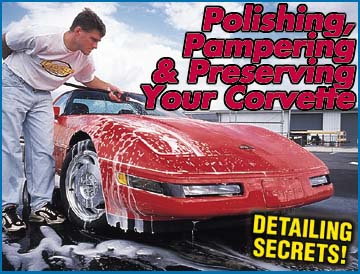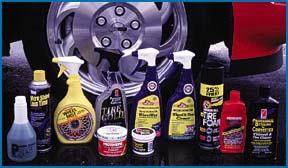
text by Richard Newton

text by Richard Newton
It's a wild world of hype when it comes to car care. Profit margins are huge, and the industry is totally unregulated. We shouldn't be surprised by all the claims made for various products - the car care industry has no truth in labeling law, and very few people have any idea what is actually inside those little plastic bottles.
We're going to look at some products and techniques and try to make some sense out of all this. Keep in mind, though, that for every product you've thrown in the trash, another five or six people swear by it.
After months of interviews and discussions, CF contributor John Pfanstiehl made the very astute observation that the best product is the one that's easiest to use. If a car care product is difficult to use, you won't use it very much, and your car will suffer accordingly. With that in mind, let's look at what's out there.

This is always step one in the process. Park your car in the shade and use lots of water to rinse it before putting soap on the paint. Leave the dish detergent in the kitchen. This is nasty stuff for your car's paint.
I've used nearly all the car soaps on the market and find very little difference among them. Foam is the big deal here. The more foam a soap makes, the easier washing becomes. A lot of people use those big sheepskin washing mitts. You can simply scoop the suds from your wash bucket and clean the surface. Just remember that if you drop the mitt on the ground, don't use it on your car again!
One little secret is to put a teaspoon of salad oil in the wash bucket. When the salad oil touches the soap, it disperses into thousands of small particles that cling to the grit and road dirt on your paint, enabling them to slide down the car without abrading the surface. The other thing to remember is to make three trips around your Corvette. The first trip will get all the dirt from the top of the car. The second will allow you to clean the upper half of the doors and fenders. The final trip is for the bottom of the panels. Most of the dirt is on the lower third of your Corvette. If you clean that part first, you'll track all those dirt particles back up to the roof.

Most of us clean the wheels as we finish cleaning the paint of our cars. The bucket is there and the hose is handy. Some people advocate using the same soap for cleaning the wheels that was used on the paint, which isn't a bad idea. The only trouble is that some brake pad dust and road dirt requires something a little stronger. But how much stronger should it be? Some cleaners will strip the clear coat right off those beautiful wheels on the late model sharks. The only wheel cleaner I've used for the past few years is P21S. Nothing can match this stuff. It's simply the best. A couple of other things to consider: never use a wheel cleaner if the wheel is hot, and if the label on the product says to avoid skin contact, do you really want to put it on your wheels?

Polish is an abrasive. It's that simple. If it doesn't have an abrasive in it, then it isn't polish. Abrasives are used to remove minor surface imperfections such as fine scratches, water spots and light oxidation. The abrasives in polish are usually mixed with oils, solvents and minerals. When we polish our Corvettes, we're creating a series of very small scratches. These fine scratches reflect light - that's how you get the paint to shine. Polishing creates a series of very fine scratches to get rid of larger scratches.
When it comes to polish, there's no truth in packaging. Most of the polishes on the market tell us that they're safe for use on clear coat paint. That statement has absolutely no meaning. Polish, by definition, is an abrasive. If you rub hard enough, you can cut through a clear coat surface. I've seen it done at an NCRS show. We just don't know how much abrasive is in a given product, which means it's impossible to compare the polishes on the market.
The one company that tries to rate their polishes is Meguiar's. They use a numbering system that's at least consistent within their own product line. For instance, No. 9 is a finer polish than No. 7. We really need some industry standardization here to help us get though all the hype. Don't look for it very soon, though.
A new item on the market is clay. Mothers, Griot's Garage, and Meguiar's all carry clay in their catalogs. This is simply another form of polish, but it's a lot rougher than most. I've asked professional painters about using clay as a polish and haven't found one yet who uses it. Professional painters feel that a 2000 grit sandpaper will do the same thing, just a little faster.
The main thing to remember when you polish is to make all your strokes in one direction. We're trying to even out all those fine scratches. The secret to that perfect show car finish is polishing. Wax won't hide your mistakes. Wax is for only one purpose - the protection of your polished paint surface. Even this is debatable. One paint expert told me that after he waxes a painted surface, there is no measurable increase in the thickness, which brings into question the whole issue of waxing - an area we really don't want to get involved in. After all, waxes and waxing are almost sacred for most of us. Please don't tell us it's useless!
Forget all the nonsense about waxes "returning the natural oils to the paint." The people who make the paint find this statement laughable. If you have any oil in your paint, folks, you've got a great big problem. The newest automotive paints are all water-based. If anyone can explain how these "natural oils" get into a water-based paint, I'll give them a free subscription to Corvette Fever.
The one thing to remember about wax is that it protects the paint. Your Corvette won't shine because of the wax you use. (The shine comes from using the proper polish, remember?) Most of the really top level show car people never put wax on the paint. They simply polish it. Then they make sure that the paint is never exposed to the elements. Their climate-controlled trailer takes the place of wax.
One little trick I've learned over the years is always to apply the wax with my hand. As I apply the wax, I can feel every little blemish in the paint. The second advantage is that, very often, the rag you use for applying the wax will actually scratch the paint. Too many people use a rag for spreading the wax around. This not only wastes a lot of the wax but if the cloth picks up any dirt, then you have an abrasive in the wax coat.
Cotton, which you can purchase at the local drug store or a medical supply store, may be the best thing for removing the wax. Diapers are very popular, but a lot of them are stitched with nylon thread - not a great thing for your paint job. Cotton balls are the ultimate tool for that final touch on your Corvette's paint.
Instant detailers - I would love to know what's in these products. I've been
using them for several years now and find them great for that little touch up
after I wash my Corvette - that extra shine that comes with very little effort.
Instant detailers provide that gloss. I have a feeling that most of it comes
from the use of glycerin, but I'm not sure. The lack of a really good product
label keeps us from knowing any more about these products. 
Corvettes' leather seats seem to hold up very well amd leather treatment is really very basic. First, you clean the surface with some sort of cleaner, and then you use some sort of oil to keep the leather supple. The cleaning part is perhaps as important as the type of leather treatment used.
One very basic treatment is to use old-fashioned saddle soap as a cleaner. Nothing on the market has proven superior. A soft bristle brush and some warm water works wonders on Corvette seats.
The best leather treatment in the world is still Hide Food. This is available from your local Rolls Royce dealer. If you can't find a Rolls dealership in your neighborhood, then you'll have to settle for something else. The most popular leather treatments come from Lexol. British car owners have been using this material for years. They sell a cleaner and a treatment process. The only problem is that, unless you buff the leather really well after application, an oily film remains. Also, it water stains easily.

Armorall
P.O. Box 24305
Dept. CF
Oakland, CA 94623
(510)
271-7000
www.armorall.com
Collinite Insulator Wax
Caswell Plating
4336 Route 31
Dept.
CF
Palmyra, NY 14522-9719
(315) 597-5140
www.caswellplating.com
Duragloss
P.O. Box 317
Dept. CF
Burlington, NC 27216
(800)
638-7245
www.spyder.net/duragloss/
Eagle One
P.O. Box 4246
Dept. CF
Carlsbad, CA 92018
(818)
501-1445
Lexol
(770) 590-0600
www.lexol.com
Meguiar's
17991 Mitchell South
Dept. CF
Irvine, CA
92614
(800) 854-8073
www.meguiars.com
Mid America Designs
P.O. Box 1368
Dept. CF
Effingham, IL
62401
(800) 500-1500
www.madvet.com
Mother's
5456 Industrial Drive
Dept. CF
Huntington Beach, CA
92649
(800) 221-8257
www.Mothers.com
Stoner
1070 Fulton Highway
Dept. CF
Quarryville, PA
17566
(888) STONER3
www.stonersolution.com
The Wax Shop
P.O. Box 10226
Dept. CF
Bakersfield, CA
93389-0226
(800) 323-9192
Zaino
4057 Hwy. 9, Suite 106
Dept. CF
Howell, NJ
07731
(732) 785-2951
www.zainobros.com

For a complete version of this story in print, look for Corvette Fever on your local newsstand.
